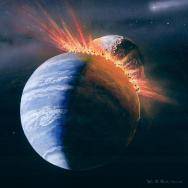How Did the Earth Form? A Scientific Explanation
The formation of Earth is a fascinating process that has been studied extensively by scientists. According to the prevailing theory, known as the nebular hypothesis, Earth formed about 4.6 billion years ago from the remnants of a giant molecular cloud. This cloud, composed primarily of hydrogen, helium, and dust, was the result of previous generations of stars that exploded in supernovae, dispersing their materials across the cosmos.
Initially, this cloud began to collapse under its own gravity, possibly triggered by shock waves from nearby supernovae. As it collapsed, it started to spin and flatten into a rotating disk. Most of the material concentrated in the center, forming the Sun, while the remaining material began to coalesce into smaller clumps, known as planetesimals. These planetesimals were the building blocks of the planets.
As the planetesimals collided and stuck together due to gravitational attraction, they formed larger bodies called protoplanets. Over millions of years, these protoplanets continued to collide and merge, gradually forming the terrestrial planets we know today, including Earth. The process was violent; numerous impacts occurred as these bodies grew in size. One of the most significant events in Earth's formation was a colossal impact with a Mars-sized body, often referred to as Theia. This impact not only contributed to Earth's mass but also led to the formation of the Moon.
During its early history, Earth was a molten mass due to the intense heat generated by these collisions and the decay of radioactive isotopes. As the planet cooled, a solid crust began to form. Volcanic activity was rampant during this time, releasing gases such as water vapor, carbon dioxide, and nitrogen into the atmosphere. This primordial atmosphere was vastly different from what we breathe today.
The cooling process also allowed water vapor to condense and form oceans. Scientists believe that Earth's oceans may have formed from water released by volcanic eruptions and from icy comets that collided with the planet. The presence of liquid water was crucial for the development of life, which would eventually emerge in these primordial seas.
As Earth continued to evolve, geological processes such as plate tectonics began to shape its surface. The movement of tectonic plates led to the formation of continents and ocean basins. Over billions of years, these processes have created a dynamic planet characterized by mountains, valleys, and various ecosystems.
The atmosphere also underwent significant changes over geological time. Early in Earth's history, it lacked free oxygen. However, around 2.4 billion years ago, a significant event known as the Great Oxidation Event occurred. Photosynthetic organisms, particularly cyanobacteria, began to produce oxygen as a byproduct of photosynthesis. This oxygen accumulated in the atmosphere, leading to dramatic changes in Earth's climate and paving the way for aerobic life forms.
In summary, Earth's formation is a complex process that involved the accretion of dust and gas in a rotating disk around the young Sun. Through collisions and gravitational interactions, planetesimals formed protoplanets, eventually leading to the creation of Earth itself. The planet's early molten state gave way to a solid crust and oceans, setting the stage for the development of life. Over billions of years, geological and biological processes have shaped Earth into the diverse and dynamic planet we inhabit today. Scientists continue to study these processes to gain a deeper understanding of our planet's history and its place in the universe.


